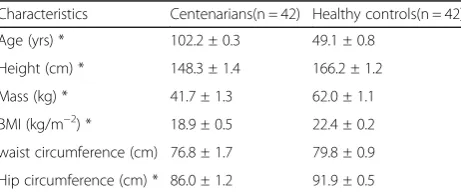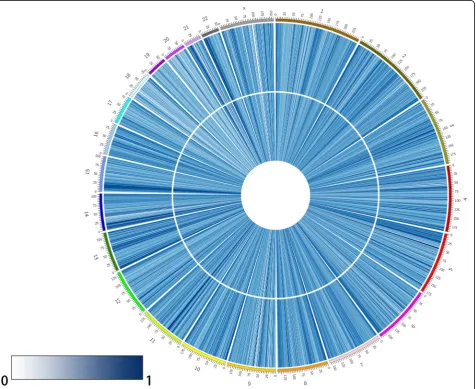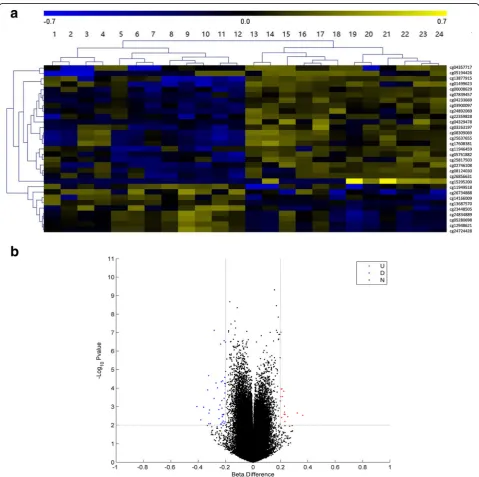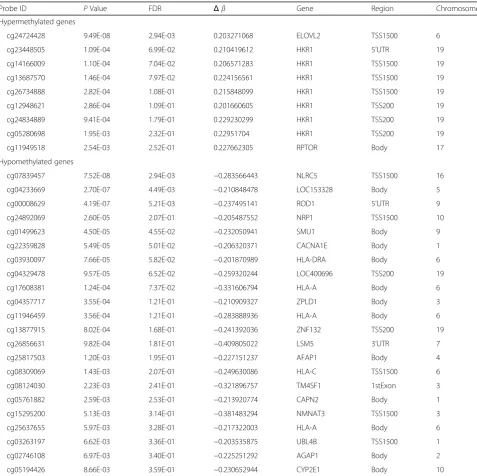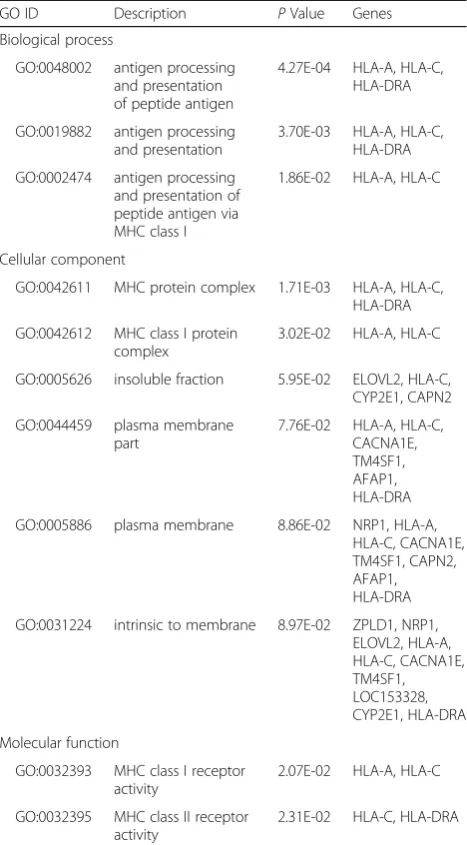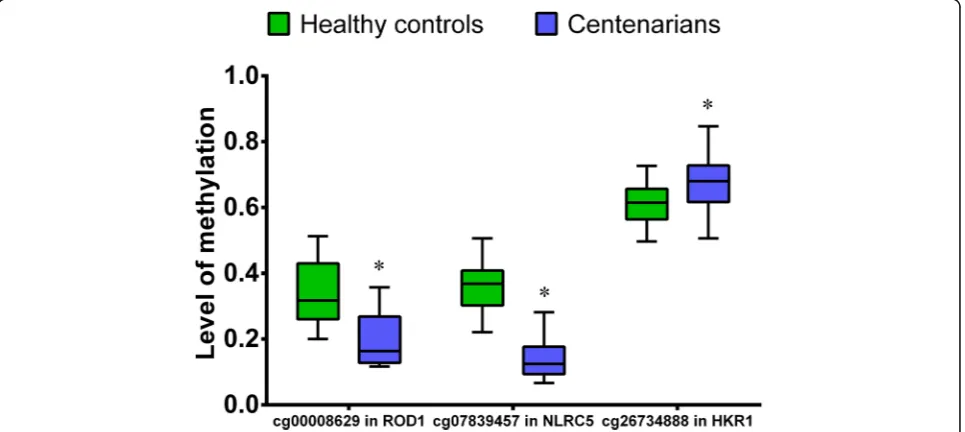R E S E A R C H A R T I C L E
Open Access
Methylation of the genes ROD1, NLRC5,
and HKR1 is associated with aging in
Hainan centenarians
Qian Zeng, Xiaoping Chen, Chaoxue Ning, Qiao Zhu, Yao Yao, Yali Zhao
*and Fuxin Luan
*Abstract
Background:Human aging is a hot topic in biology, and it has been associated with DNA methylation changes at
specific genomic sites. We aimed to study the changes of DNA methylation at a single-CpG-site resolution using peripheral blood samples from centenarians.
Methods:Using Illumina 450 K Methylation BeadChip microarray assays, we carried out a pool-based,
epigenome-wide investigation of DNA methylation of blood samples from 12 centenarians and 12 healthy controls. Differentially methylated cytosine-phosphate-guanosine (CpG) sites were selected for further pyrosequencing analysis of blood samples from 30 centenarians and 30 healthy controls.
Result: We identified a total of 31 high-confidence CpG sites with differential methylation profiles between
the groups: 9 (29%) were hypermethylated and 22 (71%) were hypomethylated in centenarians. It was also found that hypermethylation of HKR1 and hypomethylation of ROD1 and NLRC5 genes strongly correlated with age in centenarians.
Conclusion: Our results indicate that the methylation profile combination of HKR1, ROD1, and NLRC5 could
be a promising biomarker for aging in Hainan centenarians.
Keywords: DNA methylation, Aging, ROD1, NLRC5, HKR1
Background
Improvements in living conditions have meant that the average life expectancy of human beings is rising. Indeed, it has increased by approximately 10 years over the last century [1]. On the other hand, aging has attracted more and more attention. Aging is a very com-plex trait, involving environmental, genetic, and stochas-tic factors [2], and, in recent decades, has been a focus for scientists worldwide. Centenarian cohort is one of the most valuable models to study the mechanisms in-volved in human aging [3]. Centenarians are considered to have reached the extreme limits of the human life span, but still remain in relatively good health maintai-ning physiological functions and avoid succumbing to common fatal diseases [4,5]. Hainan, with a centenarian density of 21.46 per 100,000 people, is one of the most longevous regions in China. We managed to recruit 42
centenarians and 42 healthy adult controls from Hainan Province, and performed complete physical examina-tions on all subjects.
Human aging has largely been driven by extrinsic improvements to living conditions, including im-proved diet and reduced disease prevalence, as well as by both genetic and epigenetic factors [6–8]. Here, we evaluated the crucial role of epigenetic modifica-tion in gene regulamodifica-tion, with a particular focus on DNA methylation [9–11]. As early as 1975, it was proposed that DNA methylation could regulate gene activity. Methylation occurs primarily at CpG dinucle-otides, which can form CpG islands containing an above average CpG density [12, 13]. DNA methylation has been shown to regulate gene expression and plays a role in alternative silencing [14, 15]. Furthermore, CpG islands overlap the transcription start sites (TSSs) of a majority of human genes, and TSS methy-lation is known to prevent transcriptional initiation * Correspondence:zhaoyl301@163.com;baisui301@163.com
Hainan branch of PLA General Hospital, Sanya 572000, China
[16, 17]. Yet, the role of methylation in the gene body is less clear. Recent studies have demonstrated the presence of aging-associated CpG sites, which were either hypermethylated or hypomethylated [18–21].
Human genomic methylation has recently been
advanced by utilization of the Illumina Human
Methylation 450 K BeadChip Array (450 K array), which includes probes spanning 99% of human genes, evenly distributed across the genome. This system can detect the shores and shelves of CpG islands and non-CpG islands, as well as methylation sites in pro-moter regions, gene bodies, and untranslated regions (UTRs) [22–24].
In the present study, we aimed to identify DNA methylation sites by exploring differences in genomic methylation between centenarians and healthy controls. Using microarray technology and pyrosequencing and a pool-based strategy, we performed an epigenome-wide investigation of DNA methylation in a total of 42 cente-narians from Hainan Province. We found that ROD1, NLRC5, and HKR1 genes were differentially methylated between centenarians and healthy controls, suggesting they might be associated with aging in Hainan centenarians.
Methods
Subjects
This study formed part of the“Health Investigation and Longevous Mechanism Study on Centenarians in Hainan Province” project, conducted between 2014 and 2016. The subject consisted of 42 centenarians (male: 15, fe-male: 27; Han nationality) and 42 healthy adult controls (male: 18, female: 24; Han nationality). Characteristic information on centenarians and healthy controls is de-scribed in Table 1. Significant differences in characteris-tic information between centenarians and healthy controls are age-related. Healthy controls were excluded if they were suffering from known infectious diseases, or if they had a history of cancer, cardiovascular disease, or autoimmune disease. Neither the centenarians nor the healthy controls included in this study had any
infections, and neither group had received any vaccina-tions in the 15 days prior to the collection of blood samples. Peripheral blood samples were collected by morning fasting. Additional informed consent was obtained from all individual participants for whom iden-tifying information is included in this article.
Genomic DNA extraction
Peripheral blood samples were collected in EDTA-treated collection tubes by experienced nurses during a home visit, and then transferred to the Hainan branch of PLA General Hospital laboratory for processing within 4 h. Genomic DNA was extracted using a QIAamp DNA Mini kit (Qiagen, Germany), according to the manufacturer’s instructions for the Spin Procedure. DNA was eluted in 60μL of AE elution buffer, and then stored at−20 °C until use. The concentration and purity of DNA samples were assessed using a Qubit dsDNA HS Assay kit (Invitrogen, Eugene, OR, USA) according to the manufacturer’s instructions, and 1% agarose gel electrophoresis.
Microarray analysis
Infinium Human Methylation 450BeadChips (Illu-mina) were used to assay genome-wide DNA methyla-tion. The microarray chip contained 485,577 locus-specific CpG sites. Bisulfite conversion of DNA sam-ples was done using the EZ DNA Methylation Kit (Zymo Research). Microarrays were normalized by methylumi Bioconductor [25–27]. Differentially meth-ylated CpGs were selected using an algorithm in IMA Bioconductor. Probes were used in the analysis, after excluding those with a P value higher than 0.01 in more than 25% of the samples, those in chromosome Y and SNP sites. In this study, we assessed the mean-difference β-value (Δβ) between the two sample groups for each CpG site. The Illumina platform shows a significant dye bias (probe-type design differ-ences) in the two channels which will lead to bias in the estimates of Beta on the GoldenGate platform. Therefore, some normalization was required. Basically, it looks at the median intensities in the methylated and unmethylated channels (each measured in one color on the GoldenGate platform) at very low and very high beta values and sets these medians equal. And then a quantile approach was used to eliminate the batch effects among every microarray. In micro-array data analysis, false positives are loci that are found to be statistically different between conditions. However, clinical samples may have relatively high in-dividual heterogeneity, and the amount of samples is not enough. If we use p-values for multiple test cor-rections, it eliminated the false positive, but may have a certain false negative at the same time. Therefore,
Table 1Physical characteristics measures of the centenarians (n= 42) and healthy controls (n = 42)
Characteristics Centenarians(n = 42) Healthy controls(n = 42)
Age (yrs) * 102.2 ± 0.3 49.1 ± 0.8
Height (cm) * 148.3 ± 1.4 166.2 ± 1.2
Mass (kg) * 41.7 ± 1.3 62.0 ± 1.1
BMI (kg/m−2) * 18.9 ± 0.5 22.4 ± 0.2
waist circumference (cm) 76.8 ± 1.7 79.8 ± 0.9
Hip circumference (cm) * 86.0 ± 1.2 91.9 ± 0.5
we considered a probe as differentially methylated if the absolute Δβ was higher than 0.2 and the statistical test was significant (pvalue < 0.01) with wilcox [28–30].
Bioinformatic analysis
As described above, genome-wide DNA methylation was assessed using a pool-based approach, in which the
β-value for each probe represents the average methyla-tion level of all samples in the pool. To identify differ-entially methylated probes (DMPs), it was assumed that the genome-wide methylation conformed to a Gaussian model [31], and then differences in methylation be-tween the two data sets were calculated. Gene ontology (GO) and Kyoto Encyclopedia of Genes and Genomes (KEGG) pathway enrichment analyses were conducted
using the DAVID database. GO terms and KEGG infor-mation were downloaded from the Bioconductor site.
Bisulfite pyrosequencing analysis
Based on the results of the methylation microarrays, three CpG sites were selected for further pyrose-quencing analysis, using blood samples from 30 centenarians and 30 healthy controls. Bisulfite
modifi-cation of 1-2 μg DNA was performed using an
EpiTect Bisulfite kit (Qiagen) according to the manu-facturer’s instructions. Next, bisulfite pyrosequencing primers were designed using PyroMark Assay Design software version 2.0 (Qiagen). Sequencing reactions and methylation level quantification were then per-formed using the PyroMark Q96 ID system and
software (Qiagen), respectively. Pyrosequencing primer sequences are presented in additional file 1.
Statistical analyses
SPSS software version 17.0 (SPSS Inc., Chicago, IL, USA) was only used for the pyrosequencing analyses. Differences between two independent groups were
compared using Student’s t-tests and P< 0.01 was used to define statistical significance.
Results
Differential analysis of the DNA methylomes of Hainan centenarians and healthy controls
Using microarray and pyrosequencing methods, we performed an analysis of DNA methylation patterns in
centenarians and healthy controls from Hainan Province. An overview of the genome-wide methylation profiles for both groups is shown in Fig. 1. Different patterns of methylation between centenarians and healthy controls were observed at the majority of methylation loci, indi-cating that DNA methylation-based epigenetic profiles might be significant in aging. Having discovered these differences in DNA methylation, we then searched for individual DMPs. To do this, we performed a pooled-test to analyze the average methylation level at all of the CpG loci in the centenarian and healthy control groups. In total, 31 DMPs were identified using the criteria
P< 0.01 and |Δβ| > 0.2, as shown in Fig.2a and b. In this analysis, Δβ> 0.2 and Δβ<−0.2 refer to loci that were hypermethylated or hypomethylated in centenarians relative to healthy controls, respectively. Among the 31 DMPs identified, 9 were hypermethylated CpG sites and 22 were hypomethylated CpG sites (Table2).
GO and KEGG functional enrichment analysis of differentially methylated genes
Our results showed that the 31 identified significantly differentially methylated sites described above could be mapped to 23 different genes. We performed GO term
Table 2List of 31 CpG sites showing significant differences in methylation between centenarians and healthy controls
Probe ID PValue FDR Δβ Gene Region Chromosome
Hypermethylated genes
cg24724428 9.49E-08 2.94E-03 0.203271068 ELOVL2 TSS1500 6
cg23448505 1.09E-04 6.99E-02 0.210419612 HKR1 5’UTR 19
cg14166009 1.10E-04 7.04E-02 0.206571283 HKR1 TSS1500 19
cg13687570 1.46E-04 7.97E-02 0.224156561 HKR1 TSS1500 19
cg26734888 2.82E-04 1.08E-01 0.215848099 HKR1 TSS1500 19
cg12948621 2.86E-04 1.09E-01 0.201660605 HKR1 TSS200 19
cg24834889 9.41E-04 1.79E-01 0.229230299 HKR1 TSS200 19
cg05280698 1.95E-03 2.32E-01 0.22951704 HKR1 TSS200 19
cg11949518 2.54E-03 2.52E-01 0.227662305 RPTOR Body 17
Hypomethylated genes
cg07839457 7.52E-08 2.94E-03 −0.283566443 NLRC5 TSS1500 16
cg04233669 2.70E-07 4.49E-03 −0.210848478 LOC153328 Body 5
cg00008629 4.19E-07 5.21E-03 −0.237495141 ROD1 5’UTR 9
cg24892069 2.60E-05 2.07E-01 −0.205487552 NRP1 TSS1500 10
cg01499623 4.50E-05 4.55E-02 −0.232050941 SMU1 Body 9
cg22359828 5.49E-05 5.01E-02 −0.206320371 CACNA1E Body 1
cg03930097 7.66E-05 5.82E-02 −0.201870989 HLA-DRA Body 6
cg04329478 9.57E-05 6.52E-02 −0.259320244 LOC400696 TSS200 19
cg17608381 1.24E-04 7.37E-02 −0.331606794 HLA-A Body 6
cg04357717 3.55E-04 1.21E-01 −0.210909327 ZPLD1 Body 3
cg11946459 3.56E-04 1.21E-01 −0.283888936 HLA-A Body 6
cg13877915 8.02E-04 1.68E-01 −0.241392036 ZNF132 TSS200 19
cg26856631 9.82E-04 1.81E-01 −0.409805022 LSM5 3’UTR 7
cg25817503 1.20E-03 1.95E-01 −0.227151237 AFAP1 Body 4
cg08309069 1.43E-03 2.07E-01 −0.249630086 HLA-C TSS1500 6
cg08124030 2.23E-03 2.41E-01 −0.321896757 TM4SF1 1stExon 3
cg05761882 2.59E-03 2.53E-01 −0.213920774 CAPN2 Body 1
cg15295200 5.13E-03 3.14E-01 −0.381483294 NMNAT3 TSS1500 3
cg25637655 5.97E-03 3.28E-01 −0.217322003 HLA-A Body 6
cg03263197 6.62E-03 3.36E-01 −0.203535875 UBL4B TSS1500 1
cg02746108 6.97E-03 3.40E-01 −0.225251292 AGAP1 Body 2
and KEGG pathway enrichment analyses to elucidate the biological functions of these genes, using the R package GOstats described previously [32]. The biological pro-cesses, molecular functions, and cellular components that were enriched in the GO analysis of longevity-associated DMP-containing genes (DMGs) are summarized in Table3. In total, 3 biological processes, 6 cellular compo-nents, and 2 molecular function terms were enriched in the 23 DMGs. The enriched biological functions, such as antigen processing and presentation of peptide antigen (GO: 0048002) are associated with immune system func-tion. Furthermore, enriched cellular components include major histocompatibility complex (MHC) protein com-plex and insoluble fraction (GO: 0042611 and GO: 0005626, respectively). MHC receptor activity, class I and II (GO: 0032393 and GO: 0032395, respectively), are enriched molecular functions in the DMG subset.
KEGG analysis revealed the enrichment of only sev-eral pathways in the DMG subset (Table 4), with the most significantly enriched biological pathways being graft-versus-host disease (KEGG: 05332) and allograft rejection (KEGG: 05330).
Changes in ROD1, NLRC5 and HKR1 DNA methylation in centenarians
The CpGs associated with aging were not uniformly distributed across chromosomes, CpG islands, or genes; significantly differentially methylated sites were over-represented on chromosomes 3, 6, 9, and 19 (Table2).
The gene locations of the DMPs were assessed, and defined as follows: 1500 bp upstream of the TSS (TSS1500), 200 bp upstream of the TSS (TSS200), the 5’-UTR, exon 1, the gene body (encompassing all exons except exon 1), and the 3’-UTR. Some of the enriched DMPs were located within the gene body, but the role of methylation within the gene body is less clear. DNA methylation of promoter regions is a repressive epi-genetic mark that regulates gene expression. The three most significantly hypermethylated genes in the centenarian group were ELOVL fatty acid elongase 2 (ELOVL2; ID cg24724428), histidine kinase rhodop-sins 1 (HKR1; ID cg23448505; ID cg14166009; ID
Table 3Analysis of significantly hypermethylated differentially methylated probes (DMPs)
GO ID Description PValue Genes
Biological process
GO:0048002 antigen processing and presentation of peptide antigen
4.27E-04 HLA-A, HLA-C, HLA-DRA
GO:0019882 antigen processing and presentation
3.70E-03 HLA-A, HLA-C, HLA-DRA
GO:0002474 antigen processing and presentation of peptide antigen via MHC class I
1.86E-02 HLA-A, HLA-C
Cellular component
GO:0042611 MHC protein complex 1.71E-03 HLA-A, HLA-C, HLA-DRA
GO:0042612 MHC class I protein complex
3.02E-02 HLA-A, HLA-C
GO:0005626 insoluble fraction 5.95E-02 ELOVL2, HLA-C, CYP2E1, CAPN2
GO:0044459 plasma membrane part
7.76E-02 HLA-A, HLA-C, CACNA1E, TM4SF1, AFAP1, HLA-DRA
GO:0005886 plasma membrane 8.86E-02 NRP1, HLA-A, HLA-C, CACNA1E, TM4SF1, CAPN2, AFAP1, HLA-DRA
GO:0031224 intrinsic to membrane 8.97E-02 ZPLD1, NRP1, ELOVL2, HLA-A, HLA-C, CACNA1E, TM4SF1, LOC153328, CYP2E1, HLA-DRA
Molecular function
GO:0032393 MHC class I receptor activity
2.07E-02 HLA-A, HLA-C
GO:0032395 MHC class II receptor activity
2.31E-02 HLA-C, HLA-DRA
Table 4KEGG pathway enrichment analysis of significantly differentially methylated probes (DMPs)
KEGG ID Description PValue Genes
KEGG:05332 Graft-versus-host disease 1.18E-03 HLA-A, HLA-C, HLA-DRA
KEGG:05330 Allograft rejection 1.48E-03 HLA-A, HLA-C, HLA-DRA
KEGG:04940 Type I diabetes mellitus 1.91E-03 HLA-A, HLA-C, HLA-DRA
KEGG:05320 Autoimmune thyroid disease 2.92E-03 HLA-A, HLA-C, HLA-DRA
KEGG:05416 Viral myocarditis 3.50E-03 HLA-A, HLA-C, HLA-DRA
KEGG:04612 Antigen processing and presentation 6.15E-03 HLA-A, HLA-C, HLA-DRA
cg13687570; ID cg26734888; ID cg12948621; ID cg24834889; IDcg05280698) and regulatory associated protein of MTOR complex 1 (RPTOR; ID cg11949518). The CpG islands in the ELOVL2 gene was located within the gene promoter (TSS1500), HKR1 gene was located within TSS1500, TSS200 and 5’-UTR, while RPTOR genes were located within the gene body. Previous studies dem-onstrated that methylation of a CpG island within the ELOVL2 gene strongly correlates with age; indeed such methylation was declared a novel epigenetic marker for aging [33, 34]. Furthermore, seven gene sites (ID cg23448505; ID cg14166009; ID cg13687570;
ID cg26734888; ID cg12948621; ID cg24834889;
IDcg05280698) belong to the same gene(HKR1),
therefore, we chose one of HKR (ID cg26734888) to pyrosequence in a large sample set. The three most significantly hypomethylated genes in the centenarians
were NLR family CARD domain containing 5
(NLRC5; ID cg07839457), regulator of differentiation 1 (ROD1; ID cg00008629) and LOC153328 (ID cg04233669). The CpG islands in the NLRC5 gene was located TSS1500; ROD1 gene was located 5’UTR, while LOC153328 gene was located within the gene
body. It has been reported that the methylation level of CpGs within the coding region can regulate gene transcrip-tion [35]. To confirm these observations, we chose NLRC5 (ID cg07839457) and ROD1 (ID cg00008629) genes to pyr-osequence in a large sample set. In total, 60 peripheral blood samples (30 samples from each group) underwent pyrosequencing. As expected, significant differences in the level of methylation at the sites cg00008629 (ROD1), cg07839457 (NLRC5), and cg26734888 (HKR1) were ob-served between Hainan centenarians and healthy controls (Table5and Fig.3). Using a regression-based approach, we further analyzed the DNA methylation data based on cell type compositions [36]. Our further analyses indicated that the differences in the level of methylation of cg00008629 (ROD1), cg07839457 (NLRC5), and cg26734888 (HKR1) sites were significant (pvalue < 0.05) between centenarians and healthy controls (Table6).
Discussion
In our current study, we analyzed theDNA methylation of blood samples collected from centenarians and healthy controls in Hainan province, China. In summary, we found 31 DMPs using a 450 K array. Furthermore, our pyrosequencing analysis showed that methylation level at three of CpGs, ROD1, NLRC5, and HKR1 strongly correlates with aging in centenarians.
Our results also indicate that 31 high-confidence CpG sites with differential methylation profiles be-tween the groups; 9 (29%) were hypermethylated and 22 (71%) were hypomethylated in centenarians. KEGG pathway analysis showed that the most significantly
Table 5List of CpG sites showing significant differences between Hainan centenarians and healthy controls
Site Gene T P
cg00008629 ROD1 −6.388 <0.001
cg07839457 NLRC5 −12.779 <0.001
cg26734888 HKR1 3.363 0.001
enriched biological pathways being graft-versus-host disease and allograft rejection. Further studies are needed to study how these pathways relate to the aging exhibited by centenarians.
The ROD1 gene was discovered to be hypomethy-lated in centenarians. This gene encodes an RNA-binding protein that binds preferentially to poly(G) and poly(U) sequences in vitro, and was initially regarded as an inhibitor of differentiation [37]. Several ROD1 transcriptional variants, encoding different iso-forms, have been identified. In addition, ROD1 was recently found to be a member of the heterogeneous nuclear ribonucleoprotein family, which regulate the alternative splicing of pre-RNA, and can thus modu-late gene expression by repressing the expression of exons in a tissue specific manner [38, 39]. Further, ROD1 binding to C-terminal peptide was strongly inhibited by synthetic RNA and weakly inhibited by a synthetic phosphorylated peptide designed to mimic the C-terminal domain of RNA polymerase II. Inter-estingly, ROD1 expression and knockdown experi-ments suggest a role in the regulation of C-terminal peptide mitogenic activity [40], suggesting a potential correlation between hypomethylation of ROD1 gene and aging in centenarians.
NLRC5, a member of the NOD-like receptor gene family and widely expressed in tumor tissues, is a key transcriptional regulator of MHC class I mole-cules [41, 42]. Cancers can escape immune surveil-lance by reducing the expression of MHC class I molecules. NLRC5, an important regulator of innate immune responses, may affect patient survival by regulating this immune evasion via MHC class I molecules. NLRC5 could therefore be exploited to
restore tumor immunogenicity and to stimulate
protective antitumor immunity [43]. While the role of NLRC5 in both innate and adaptive immune signaling is well established, its function in inflam-mation remains poorly understood. The regulation of NF-κB activation is crucial for many biological func-tions, and NF-κB dysregulation is associated with immune deficiency, infectious disease, inflammation, and cancer [44, 45]. NLRC5 has been reported to in-hibit NF-κB activation by interacting with IKK-α/−β and blocking its phosphorylation [46]. To date, there
have been no reports which implicate NLRC5 in aging, however, we found that NLRC5 was
hypo-methylated in centenarians. Methylation of the
NLRC5 is negatively correlated with NLRC5 expres-sion in many cells [47, 48]. It is possible that this NLRC5 hypomethylation is involved in aging through the regulation of various biological pathways.
In contrast to ROD1 and NLRC5, HKR1 was hyper-methylated in centenarians. HKR1 encodes Krueppel-related zinc finger protein 1, a member of the GLI-Kruppel zinc finger family that is important for gene regulation [49]. The HKR1 protein possesses a serine/threonine-rich domain, and a Ca2+-binding consensus sequence within its cytoplasmic domain. Recently, HKR1 mRNA expressions were found to be higher in lung cancer tissues than in normal lung tissues, and HKR1 may be involved in the regulation of a signaling pathway involved in lung cancer progression [50]. Although the physiological roles of HKR1 remain unclear, HKR1 knockout is le-thal, indicating that this gene is essential for survival. Further research is needed to fully understand the significance of HKR1 hypermethylation in centenar-ians and its effect on aging.
However, it is worth mentioning that peripheral blood is a heterogeneous collection of different cell types, each with a very different DNA methylation profile. Differences in the relative proportions of these components may contribute to differences in DNA methylation [51–53]. To identify the potential effect of cellular proportions in the DNA methylation differ-entiation, we used a regression-based approach to adjusting for cell type composition in DNA methyla-tion data. Our results indicated that the methylamethyla-tion
cg00008629 (ROD1), cg07839457 (NLRC5), and
cg26734888 (HKR1) were also found significant differ-ences between centenarians and healthy controls.
To our knowledge, the association between the genes ROD1, NLRC5, and HKR1 and aging have not been previously reported. We here found significantly different levels of DNA methylation at the ROD1, NLRC5, and HKR1 genes in centenarians and healthy controls. Our findings implicate that these genes may play important roles in aging via the regulation of various biological pathways and could be used as biomarker genes for aging.
Table 6List of 3 CpG sites showing significant differences in methylation between centenarians and healthy controls after adjusted for cell type composition in DNA methylation data
Site Gene P(before cell type correction) P(after cell type correction)
cg00008629 ROD1 4.19E-07 3.48 E-02
cg07839457 NLRC5 7.52E-08 1.99 E-02
Conclusions
In summary, we present a comprehensive comparison of genomic methylation in centenarians and healthy controls residing in Hainan Province. We report an epi-genetic signature consisting of three genes, which can be used to estimate aging from blood samples. Changes to the methylation of CpG islands, namely, hypomethyla-tion within the ROD1 and NLRC5 and hypermethylahypomethyla-tion within HKR1 genes, are possibly correlated with aging in centenarians. While further studies are required to understand the mechanisms and signaling pathways through which ROD1, NLRC5, and HKR1 methylation affect aging, the methylation of these genes constitutes a signature that could be used to evaluate aging. The com-bination of ROD1, NLRC5, and HKR1 gene methylation is therefore a potential novel biomarker for aging.
Additional file
Additional file 1:“Pyrosequencing primer sequences of three sites”. This file contains detailed description of pyrosequencing primer sequences. (DOCX 12 kb)
Abbreviations
CpG:cytosine-phosphate-guanosine; DMG: DMP-containing genes; DMP: Differentially methylated probe; ELOVL2: ELOVL fatty acid elongase 2; GO: Gene ontology; HKR1: Histidine kinase rhodopsins 1; KEGG: Kyoto Encyclopedia of Genes and Genomes; MHC: Major histocompatibility complex; NLRC5: NLR family CARD domain containing 5; ROD1: Regulator of differentiation 1; TSS: Transcription start sites; UTR: Untranslated regions
Acknowledgements
We appreciate all the participants of the Hainan Centenarian Study for their continued cooperation. We thank Hanqi Yin (Guangdong Longsee biomedical corporation) for guidance on data analysis.
Funding
This study was funded by Key research funding of Hainan (grant nos. 16A200143 and 14A110069), and Key Research and Development Project of Hainan (grant nos. ZDYF2016135 and ZDYF2017095). There is no role of the funding body in the design of the study and collection, analysis, and interpretation of data and in writing the manuscript.
Availability of data and materials
The datasets used and analyzed during the current study are available from the corresponding author on reasonable request.
Authors’contributions
QZ designed the study and drafted the manuscript. XPC and QZH conducted experiments. CXN performed statistical analyses. YY prepared the samples. YLZ and FXL conceived the study, participated in its design and coordination, and helped to draft the manuscript. The authors declare that they have no conflict of interest. All authors have read and approved the final manuscript.
Ethics approval and consent to participate
Prior to investigation and physical examination, we have got the consent from the participants or from their family members such as sons and daughter-in-laws. If the participants could not sign their names because of illiteracy or being cognitive-impaired, their names were signed by their direct relatives after the consent of the participants. The Ethics Committee of the Hainan branch of the Chinese People’s Liberation Army General Hospital (Sanya, Hainan) approved the study protocol (No. of serial: 301hn11201601).
Consent for publication
Not applicable.
Competing interests
On behalf of all authors, the corresponding author states that there is no conflict of interest.
Publisher’s Note
Springer Nature remains neutral with regard to jurisdictional claims in published maps and institutional affiliations.
Received: 22 August 2017 Accepted: 25 January 2018
References
1. Vaupel JW. Biodemography of human ageing. Nature. 2010;464(7288):536–42. 2. Singh R, Kolvraa S, Rattan SI. Genetics of human longevity with emphasis on
the relevance of HSP70 as candidate genes. Front Biosci. 2007;12:4504–13. 3. Franceschi C, Bonafe M. Centenarians as a model for healthy aging.
Biochem Soc Trans. 2003;31(2):457–61.
4. Brooks-Wilson AR. Genetics of healthy aging and longevity. Hum Genet. 2013;132(12):1323–38.
5. He YH, Zhang YX, Yang LQ, Liao XP, Zhang QY, Cai WW, Kong QP. Assessment of the health status of centenarians in the south of China: a cross-sectional study. J Am Geriatr Soc. 2014;62(7):1402–4.
6. Iannitti T, Palmieri B. Inflammation and genetics: an insight in the centenarian model. Hum Biol. 2011;83(4):531–59.
7. Browner WS, Kahn AJ, Ziv E, Reiner AP, Oshima J, Cawthon RM, Hsueh WC, Cummings SR. The genetics of human longevity. Am J Med. 2004;117(11):851–60.
8. Vijg J, Suh Y. Genome instability and aging. Annu Rev Physiol. 2013;75:645–68. 9. Xiao FH, He YH, Li QG, Wu H, Luo LH, Kong QP. A genome-wide scan
reveals important roles of DNA methylation in human longevity by regulating age-related disease genes. PLoS One. 2015;10(3):e0120388. 10. Xiao FH, Kong QP, Perry B, he YH. progress on the role of DNA methylation
in aging and longevity. Brief Funct Genomics. 2016;15(6):454–9.
11. Kaplow IM, JL MI, Mah SM, McEwen LM, Kobor MS, Fraser HB. a pooling-based approach to mapping genetic variants associated with DNA methylation. Genome Res. 2015;25(6):907–17.
12. Riggs AD. X inactivation, differentiation, and DNA methylation. Cytogenet Cell Genet. 1975;14(1):9–25.
13. Holliday R, Pugh JE. DNA modification mechanisms and gene activity during development. Science. 1975;187(4173):226–32.
14. Watt F, Molloy PL. Cytosine methylation prevents binding to DNA of a HeLa cell transcription factor required for optimal expression of the adenovirus major late promoter. Genes Dev. 1988;2(9):1136–43.
15. Nan X, Campoy FJ, Bird A. MeCP2 is a transcriptional repressor with abundant binding sites in genomic chromatin. Cell. 1997;88(4):471–81. 16. Illingworth RS, Bird AP. CpG islands–'a rough guide. FEBS Lett. 2009;
583(11):1713–20.
17. Deaton AM, Bird A. CpG islands and the regulation of transcription. Genes Dev. 2011;25(10):1010–22.
18. Fraga MF, Ballestar E, Paz MF, Ropero S, Setien F, Ballestar ML, Heine-Suner D, Cigudosa JC, Urioste M, Benitez J, et al. epigenetic differences arise during the lifetime of monozygotic twins. Proc Natl Acad Sci U S A. 2005; 102(30):10604–9.
19. Christensen BC, Houseman EA, Marsit CJ, Zheng S, Wrensch MR, Wiemels JL, Nelson HH, Karagas MR, Padbury JF, Bueno R, et al. Aging and
environmental exposures alter tissue-specific DNA methylation dependent upon CpG island context. PLoS Genet. 2009;5(8):e1000602.
20. Alisch RS, Barwick BG, Chopra P, Myrick LK, Satten GA, Conneely KN, Warren ST. Age-associated DNA methylation in pediatric populations. Genome Res. 2012;22(4):623–32.
21. Bork S, Pfister S, Witt H, Horn P, Korn B, Ho AD, Wagner W. DNA methylation pattern changes upon long-term culture and aging of human mesenchymal stromal cells. Aging Cell. 2010;9(1):54–63.
22. Horvath S. DNA methylation age of human tissues and cell types. Genome Biol. 2013;14(10):R115.
changes in DNA methylation and gene expression in human PBMCs. Age (Dordr). 2014;36(3):9648.
24. Hannum G, Guinney J, Zhao L, Zhang L, Hughes G, Sadda S, Klotzle B, Bibikova M, Fan JB, Gao Y, et al. Genome-wide methylation profiles reveal quantitative views of human aging rates. Mol Cell. 2013;49(2):359–67. 25. Pidsley R, CC YW, Volta M, Lunnon K, Mill J, Schalkwyk LC. A data-driven
approach to preprocessing Illumina 450K methylation array data. BMC Genomics. 2013;14:293.
26. Yousefi P, Huen K, Aguilar Schall R, Decker A, Elboudwarej E, Quach H, Barcellos L, Holland N. Considerations for normalization of DNA methylation data by Illumina 450K BeadChip assay in population studies. Epigenetics. 2013;8(11):1141–52.
27. Du P, Kibbe WA, Lin SM. Lumi: a pipeline for processing Illumina microarray. Bioinformatics. 2008;24(13):1547–8.
28. Sun Z, Chai HS, Wu Y, White WM, Donkena KV, Klein CJ, Garovic VD, Therneau TM, Kocher JP. Batch effect correction for genome-wide methylation data with Illumina Infinium platform. BMC Med Genet. 2011;4:84.
29. Sandoval J, Heyn H, Moran S, Serra-Musach J, Pujana MA, Bibikova M, Esteller M. Validation of a DNA methylation microarray for 450,000 CpG sites in the human genome. Epigenetics. 2011;6(6):692–702.
30. Nordlund J, Backlin CL, Wahlberg P, Busche S, Berglund EC, Eloranta ML, Flaegstad T, Forestier E, Frost BM, Harila-Saari A, et al. Genome-wide signatures of differential DNA methylation in pediatric acute lymphoblastic leukemia. Genome Biol. 2013;14(9):r105.
31. Guo JU, Ma DK, Mo H, Ball MP, Jang MH, Bonaguidi MA, Balazer JA, Eaves HL, Xie B, Ford E, et al. Neuronal activity modifies the DNA methylation landscape in the adult brain. Nat Neurosci. 2011;14(10):1345–51. 32. Falcon S, Gentleman R. Using GOstats to test gene lists for GO term
association. Bioinformatics. 2007;23(2):257–8.
33. Garagnani P, Bacalini MG, Pirazzini C, Gori D, Giuliani C, Mari D, Di Blasio AM, Gentilini D, Vitale G, Collino S, et al. Methylation of ELOVL2 gene as a new epigenetic marker of age. Aging Cell. 2012;11(6):1132–4.
34. Bacalini MG, Deelen J, Pirazzini C, De Cecco M, Giuliani C, Lanzarini C, Ravaioli F, Marasco E, van Heemst D, Suchiman HE, et al. Systemic age-associated DNA Hypermethylation of ELOVL2 gene: in vivo and in vitro evidences of a cell replication process. J Gerontol A Biol Sci Med Sci. 2016; 35. Ding Y, He F, Wen H, Li J, Ni M, Chi M, Qian K, Bu Y, Zhang D, Si Y, et al.
DNA methylation status of cyp17-II gene correlated with its expression pattern and reproductive endocrinology during ovarian development stages of Japanese flounder (Paralichthys Olivaceus). Gene. 2013;527(1):82–8. 36. Jones MJ, Islam SA, Edgar RD, Kobor MS. Adjusting for cell type
composition in DNA methylation data using a regression-based approach. Methods Mol Biol. 2017;1589:99–106.
37. Yamamoto H, Tsukahara K, Kanaoka Y, Jinno S, Okayama H. Isolation of a mammalian homologue of a fission yeast differentiation regulator. Mol Cell Biol. 1999;19(5):3829–41.
38. Maniatis T, Tasic B. Alternative pre-mRNA splicing and proteome expansion in metazoans. Nature. 2002;418(6894):236–43.
39. Spellman R, Llorian M, Smith CW. Crossregulation and functional redundancy between the splicing regulator PTB and its paralogs nPTB and ROD1. Mol Cell. 2007;27(3):420–34.
40. Sadvakassova G, Dobocan MC, Difalco MR, Congote LF. Regulator of differentiation 1 (ROD1) binds to the amphipathic C-terminal peptide of thrombospondin-4 and is involved in its mitogenic activity. J Cell Physiol. 2009;220(3):672–9.
41. Meissner TB, Li A, Liu YJ, Gagnon E, Kobayashi KS. The nucleotide-binding domain of NLRC5 is critical for nuclear import and transactivation activity. Biochem Biophys Res Commun. 2012;418(4):786–91.
42. Staehli F, Ludigs K, Heinz LX, Seguin-Estevez Q, Ferrero I, Braun M, Schroder K, Rebsamen M, Tardivel A, Mattmann C, et al. NLRC5 deficiency selectively impairs MHC class I- dependent lymphocyte killing by cytotoxic T cells. J Immunol. 2012;188(8):3820–8.
43. Rodriguez GM, Bobbala D, Serrano D, Mayhue M, Champagne A, Saucier C, Steimle V, Kufer TA, Menendez A, Ramanathan S, et al. NLRC5 elicits antitumor immunity by enhancing processing and presentation of tumor antigens to CD8(+) T lymphocytes. Oncoimmunology. 2016;5(6):e1151593. 44. Liu B, Park E, Zhu F, Bustos T, Liu J, Shen J, Fischer SM, Hu Y. A critical role
for I kappaB kinase alpha in the development of human and mouse squamous cell carcinomas. Proc Natl Acad Sci U S A. 2006;103(46):17202–7.
45. Pannicke U, Baumann B, Fuchs S, Henneke P, Rensing-Ehl A, Rizzi M, Janda A, Hese K, Schlesier M, Holzmann K, et al. Deficiency of innate and acquired immunity caused by an IKBKB mutation. N Engl J Med. 2013;369(26):2504–14. 46. Cui J, Zhu L, Xia X, Wang HY, Legras X, Hong J, Ji J, Shen P, Zheng S, Chen ZJ, et al. NLRC5 negatively regulates the NF-kappaB and type I interferon signaling pathways. Cell. 2010;141(3):483–96.
47. Yoshihama S, Vijayan S, Sidiq T, Kobayashi KS. NLRC5/CITA: a key player in cancer immune surveillance. Trends Cancer. 2017;3(1):28–38.
48. Yoshihama S, Roszik J, Downs I, Meissner TB, Vijayan S, Chapuy B, Sidiq T, Shipp MA, Lizee GA, Kobayashi KS. NLRC5/MHC class I transactivator is a target for immune evasion in cancer. Proc Natl Acad Sci U S A. 2016;113(21): 5999–6004.
49. Ruppert JM, Kinzler KW, Wong AJ, Bigner SH, Kao FT, Law ML, Seuanez HN, O'Brien SJ, Vogelstein B. The GLI-Kruppel family of human genes. Mol Cell Biol. 1988;8(8):3104–13.
50. Oguri T, Katoh O, Takahashi T, Isobe T, Kuramoto K, Hirata S, Yamakido M, Watanabe H. the Kruppel-type zinc finger family gene, HKR1, is induced in lung cancer by exposure to platinum drugs. Gene. 1998;222(1):61–7. 51. Teschendorff AE, Zheng SC. Cell-type deconvolution in epigenome-wide
association studies: a review and recommendations. Epigenomics. 2017;9(5): 757–68.
52. Jaffe AE, Irizarry RA. Accounting for cellular heterogeneity is critical in epigenome-wide association studies. Genome Biol. 2014;15(2):R31. 53. McEwen LM, Morin AM, Edgar RD, MacIsaac JL, Jones MJ, Dow WH,
Rosero-Bixby L, Kobor MS, Rehkopf DH. Differential DNA methylation and lymphocyte proportions in a costa Rican high longevity region. Epigenetics Chromatin. 2017;10:21.
• We accept pre-submission inquiries
• Our selector tool helps you to find the most relevant journal
• We provide round the clock customer support
• Convenient online submission
• Thorough peer review
• Inclusion in PubMed and all major indexing services
• Maximum visibility for your research
Submit your manuscript at www.biomedcentral.com/submit
